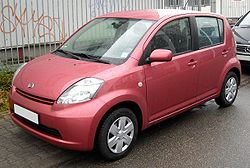- Daihatsu Boon
-
Daihatsu Daihatsu Sirion (2005–2007)
Boon / Sirion II Hersteller: Daihatsu Produktionszeitraum: seit 2005 Klasse: Kleinwagen Karosserieversionen: Schrägheck, fünftürig Motoren: Ottomotoren:
1,0–1,5 Liter
(41–76 kW)Länge: 3630 mm Breite: 1665 mm Höhe: 1550 mm Radstand: 2440 mm Leergewicht: 980 kg Vorgängermodell: Daihatsu Sirion I Nachfolgemodell: keines Der Daihatsu Boon ist ein Kleinwagen der auch als Toyota Passo erhältlich ist. Das erste Modell des Boon wird in Europa als Daihatsu Sirion II angeboten. Von 2007 bis 2011 wurde der Boon I in Europa auch als Subaru Justy angeboten.
Inhaltsverzeichnis
Daihatsu Boon / Sirion II (Typ M300G)
2005 erschien der Boon als Daihatsu Sirion II in Europa. Angetrieben wird er entweder von einem 1,0L Dreizylinder oder 1,3L Vierzylinder Benzinmotor. Der 1,0L Motor findet in modifizierter Form auch in den Modellen Citroen C1, Peugeot 107 und Toyota Aygo Verwendung. Das aktuelle Modell wurde speziell für den europäischen Markt entwickelt. In Japan dient es nur als Nischenmodell, da hier andere Modelle vorherrschend sind. Das Design ist funktional und soll gleichzeitig emotional ansprechen. Optional ist Allradantrieb erhältlich ebenso wie ein CVT-Getriebe. 2007 fand eine leichte Modifizierung statt.
Motorisierungen Boon / Sirion II Europa
- Sirion 1.0 Dreizylinder mit 998 cm³ Hubraum und 51 kW (70 PS) (5,0 l/100 km, 118 g/km CO2[1]),2005−
- Sirion 1.3 (4 Zylinder, 64 kW, 87 PS, 5,8 l/100 km, 137 g/km)
- Sirion 1.3 (nach der Modellpflege im Oktober 2007 4 Zylinder, 67 kW, 91 PS, 5,8 l/100 km, 137 g/km, 11,3 s 0–100 km/h)
- Sirion 1.3 Eco 4WD (4 Zylinder, 67 kW, 91 PS, 6,3 l/100 km, 148 g/km)
- Sirion 1.5 Vierzylinder mit 1495 cm³ Hubraum und 76 kW (103 PS), (6,3 l/100 km, 145 g/km), 2008−2010
Daihatsu Boon II (Typ M600)
Daihatsu Daihatsu Boon
Boon II Hersteller: Daihatsu Produktionszeitraum: seit 2010 Klasse: Kleinwagen Karosserieversionen: Schrägheck, fünftürig Motoren: Ottomotoren:
1,0–1,3 LiterLänge: 3640-3650 mm Breite: 1665 mm Höhe: 1535 mm Radstand: 2440 mm Leergewicht: 910-970 kg Vorgängermodell: keines Nachfolgemodell: keines Seit Februar 2010 gibt es in Japan einen neuen Daihatsu Boon der auch wieder als Toyota Passo angeboten wird. Da Daihatsu sich vom europäischen Markt zurückzieht, wird das Modell nicht mehr nach Europa importiert. Motoren sind wieder die 1,0L und 1,3L Benzinmotoren mit optionalem Allradantrieb. Ebenfalls optional ist ein CV-T Automatikgetriebe erhältlich.
Quellen
- ↑ Zeitschrift Ökotest 3/2007, S. 101
Weblinks
 Commons: Daihatsu Boon – Sammlung von Bildern, Videos und Audiodateien
Commons: Daihatsu Boon – Sammlung von Bildern, Videos und Audiodateien Commons: Daihatsu Sirion – Sammlung von Bildern, Videos und AudiodateienAutomodelle von Daihatsu
Commons: Daihatsu Sirion – Sammlung von Bildern, Videos und AudiodateienAutomodelle von DaihatsuAktuelle Modelle: Altis | Atrai | Be‣go/Terios | Boon | Charade | Copen | Cuore/Mira | Delta | Esse | Hijet | Materia/Coo | Move | Move Conte | Move Latte | Sirion | Sonica | Tanto | Terios/Be‣go | Terios Kid | Trevis/Mira Gino | Xenia
Eingestellte Modelle: Applause | Atrai 7 | Bee | Charade | Charmant | Compagno | Consorte | Fellow | Fellow Max | Feroza | Gran Move/Pyzar | Hiline | Leeza | Max | Midget | Midget II | Naked | Opti | Rocky/Rugger | Storia | Vesta | Wildcat/Taft | YRV
Wikimedia Foundation.
Schlagen Sie auch in anderen Wörterbüchern nach:
Daihatsu Boon — Manufacturer Daihatsu Motor Company Production 2004 present Predecessor Daihatsu Storia … Wikipedia
Daihatsu — Motor Co., Ltd. ダイハツ工業株式会社 Rechtsform Kabushiki gaisha (Aktiengesellschaft) ISIN JP34 … Deutsch Wikipedia
Daihatsu Sirion — Fabricante Daihatsu Período 1998 presente … Wikipedia Español
Daihatsu Sirion — I Daihatsu Sirion phase I Constructeur Daihatsu Années de production 1998 fin 2004 Cl … Wikipédia en Français
Daihatsu Mira Gino — Manufacturer Daihatsu Also called Daihatsu Trevis Production 1999–2009 … Wikipedia
Daihatsu Storia — Daihatsu Daihatsu Sirion (1998–2002) Storia / SirionI Hersteller: Daihatsu Produktionszeitraum … Deutsch Wikipedia
Daihatsu Storia — Manufacturer Daihatsu Motor Company Also called Daihatsu Sirion Toyota Duet P … Wikipedia
Daihatsu Sirion I — Daihatsu Sirion Daihatsu Sirion I Constructeur Daihatsu Classe Compacte Moteur et transmission Architecture moteur … Wikipédia en Français
Daihatsu Sirion II — Daihatsu Sirion Daihatsu Sirion I Constructeur Daihatsu Classe Compacte Moteur et transmission Architecture moteur … Wikipédia en Français
Daihatsu — Logo de Daihatsu Création 13,Mars,1907 … Wikipédia en Français





